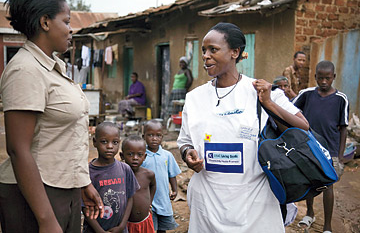The concept is simple and brilliant. When I came across Living Goods, my stomach flipped with the potential impact of the organization’s work. The mechanisms, intent and appeal match that of blockbuster social enterprises Kiva and charity: water.
 Living Goods replicates Avon’s model of door-to-door selling, but instead of peddling lipstick and mascara to middle-class women, Living Goods’ Health Promoters sell affordable health products–from antibacterial soap to de-worming tablets to condoms to bednets–to the Ugandan poor. By providing a way for women to make a living by selling products that prevent unnecessary death from treatable diseases, Living Goods is fighting the double-headed dragon of mortality and poverty.
Living Goods replicates Avon’s model of door-to-door selling, but instead of peddling lipstick and mascara to middle-class women, Living Goods’ Health Promoters sell affordable health products–from antibacterial soap to de-worming tablets to condoms to bednets–to the Ugandan poor. By providing a way for women to make a living by selling products that prevent unnecessary death from treatable diseases, Living Goods is fighting the double-headed dragon of mortality and poverty.
More than 10 million children die every year (pause for a second; that’s 27,398 deaths a day) from easily treatable conditions like malaria, TB and diarrhoeal disease. Products for prevention and treatment exist, but efficient and scalable delivery systems are lacking. Living Goods uses micro-enterprise and micro-franchising to get these products into communities and to keep them there. Health Promoters buy a business-in-a-box for $100-$250, which includes the products, as well as training, marketing and coaching. Living Goods and its partners–one of whom is the microfinance and development organization BRAC–provide affordable financing for the kits.
Malaria, as one example, deals a double blow by causing economic as well as physical suffering. Reoccurring and prolonged bouts with malaria prevent people from working. Living Goods is committed to inverting this cycle by incentivizing its Health Promoters (through profit) to make essential health products available to more people. The more a Health Promoter does this, the larger her profit and the greater the health impact she will have on her community.
Over the next five years, Living Goods aims to become financially self-sustaining and to replicate its model in other countries. Charles Slaughter, Living Goods’ founder and president, is very open to helping other social enterprises adopt or replicate the model. Partnering with the Poverty Action Lab* (PAL), Living Goods is tracking its impact through randomized control studies as it works to lower mortality rates for children under five by 15-30% in its target communities.
Child and community health, female economic development, financial sustainability, open-source replication, local support, microfinance micro-enterprise–these outcomes and mechanisms give me an adrenaline jolt. Why have I not heard of Living Goods earlier? If you’re as moved by Living Goods’ approach and mission as I am, you can sign up for its e-newsletter or make a donation. Living Goods doesn’t yet have a Twitter or Facebook presence (but I’m about to offer to help develop it for them).
*The New Yorker recently wrote a great profile on PAL and the organization’s co-founder Esther Duflo.





 I'm Olivia Khalili. I created Cause Capitalism to show you how to grow your business by incorporating a social mission.
I'm Olivia Khalili. I created Cause Capitalism to show you how to grow your business by incorporating a social mission. 

Wow. really liked this story. It seems like a good strategy. I wonder if the Ugandan poor even have discretionary money for such things as bednets. But it is a creative way to educate and to get products out there. It also has potential to engage whole communities in group purchasing, etc.
Thanks for bringing it to my attention.
Thanks for reading and leaving a comment, Mary. I’m so glad you asked that question (I should have included this explanation in the post). Living Goods’ target communities, although poor, have some discretionary income to afford low-cost (maybe even subsidized) health products. I’m curious about what the monthly average income is for these communities.
Group purchasing is a great strategy!
Love the concept behind Living Goods! Selling products at reasonable prices that people need (and can save lives) plus providing economic opportunities for the people selling the products. Thanks for bringing awareness to Living Goods and their work. I will definitely look into them for when we go to Uganda. Would be fascinating to see their work on the ground!
Audrey,
That would so interesting! They are working with BRAC and the Ugandan Ministry of Health in more than 20 communities in Uganda. Here’s a link to these communities: http://www.livinggoods.org/work.asp
I can’t wait to follow your work in Africa!